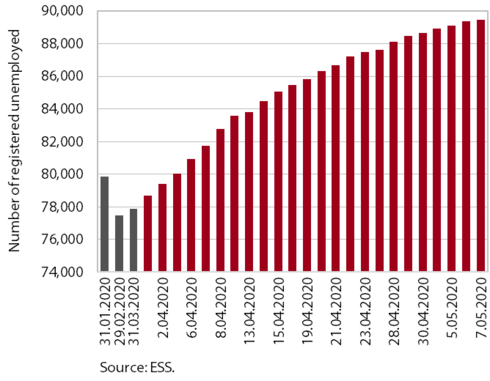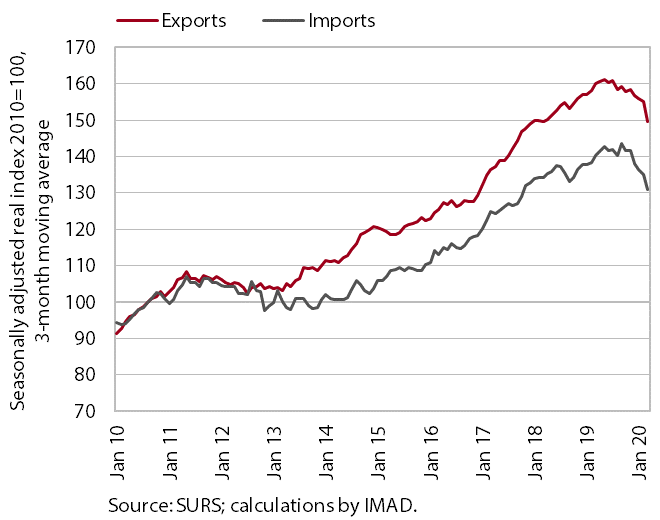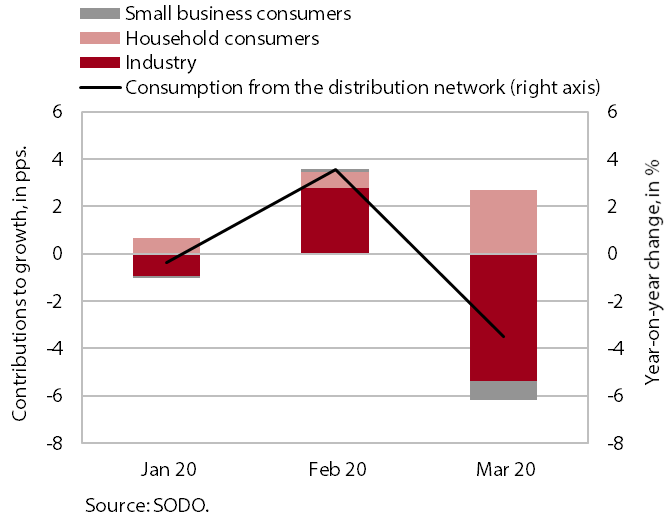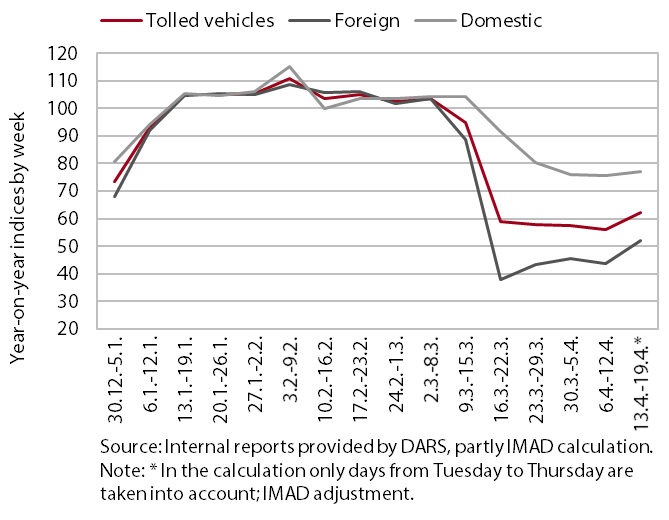Charts of the Week
Current economic trends from 4 to 8 May 2020: registered unemployment, exports and imports of goods, electricity consumption and traffic of electronically tolled vehicles
Growth in the number of registered unemployed persons, which was extremely high particularly in the first half of April, has slowed in recent weeks. As a result of the coronavirus epidemic and measures to contain its spread, goods trade with the EU fell sharply in March, most notably exports to Italy. Owing to a decline in activity in most sectors, industrial electricity consumption fell significantly in Slovenia in March. Small business consumption was also lower, while household consumption increased, which can be attributed to the restrictions on movement and gathering and the shift to remote work.
Registered unemployment, April – May 2020

The number of registered unemployed persons started to increase markedly in the middle of March with the adoption of measures to contain the coronavirus epidemic; in the last weeks, its growth has eased slightly. By the end of April, the number of unemployed persons had risen to 88,648, which is 19.9% more than one year earlier. By 7 May it had further increased by around 800 persons, according to EES unofficial (daily) data. Among the newly registered, significantly more persons lost work (than before the outbreak of the epidemic) because their fixed-term employment contracts were not renewed or for business reasons. The largest inflow into unemployment came from accommodation and food service activities, trade and manufacturing. In the last few weeks, the rise in the number of unemployed persons has eased somewhat, which could be related to the expected easing of some containment measures and the adoption of the second legislative package to mitigate the economic impact of the crisis.
Exports and imports of goods, March 2020

Trade in goods, especially with EU countries, declined markedly in March with the spread of the coronavirus epidemic in neighbouring countries in particular. After goods exports to the EU had already been slowing gradually for several months, the noticeable decline in March was mainly due to measures to contain the epidemic in Slovenia’s main trading partners. The sharpest decline was recorded for exports to Italy, where, in addition to the closure of most shops, all non-essential production came to a standstill in the second half of the month. Owing to disruptions in international transport, significantly worse expectations about orders and the adoption of measures to contain the epidemic in Slovenia, imports also fell markedly in March.
Electricity consumption by consumption group, March 2020

In Slovenia, the decline in electricity consumption at the distribution level in March was mostly due to lower industrial consumption. The total electricity consumption of consumers connected to the distribution system decreased by 3.5% year on year. The largest contribution (5.4 pps) to the decline came from lower industrial consumption (down around 9% year on year), which was a consequence of the closure of some production plants and non-essential service activities due to the coronavirus epidemic. The contribution of small business consumption was also negative, albeit far smaller (0.8 pps). Household consumption, which was around 9% higher year on year, made a positive contribution to growth (2.7 pps), as owing to the adopted measures people have mostly stayed at home since the middle of March.
Traffic of electronically tolled vehicles on Slovenian motorways, April – May 2020

Freight traffic on Slovenian motorways, which has fallen markedly since the declaration of the epidemic, started to increase again in the middle of April. After a more than 40% decline in the first weeks following the declaration of the epidemic, it was around a fifth lower in the week of the Labour Day holidays compared with the same period of last year. The distance of journeys performed by foreign trucks was approximately 30% lower year on year, while that performed by domestic trucks already approached the levels seen before the epidemic. The decline in foreign truck traffic, which was significantly larger than in domestic truck traffic at the beginning of the epidemic, decreased under the impact of EU measures to ensure the free flow of goods across borders and due to the relaxation of measures in some neighbouring countries.
